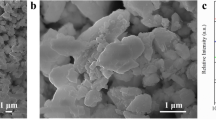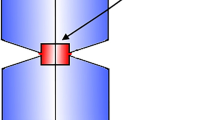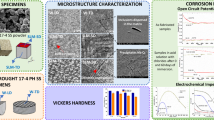Abstract
Cubic 8 mol% Y2O3-stabilised ZrO2 is well known for its good oxygen conductivity and therefore it is used in fuel cells, as oxygen sensor for liquid metals and as pH sensor in high temperature water. As a part of its fracture toughness assessment, the crack system caused by Vickers hardness indentations was examined by breaking specimens along an indentation diagonal. It was found that, although the normally observed fracture mode is transgranular, intergranular fracture occurred in the zone below an indentation. Annealing the specimen above 900 °C before breaking caused the disappearance of this effect. The intergranular fracture mode was explained by the combined effect of plastic deformation under the indentation and environmental humidity. Annealing is expected to cause restoration to the un-deformed structure. Observations on the intergranular and transgranular cracking pattern, slow crack growth occurrence and step formation at the fracture surface, are reported.


















Similar content being viewed by others
References
Atkinson A, Selçuk A (2000) Mechanical behaviour of ceramic oxygen ion-conducting membranes. Solid State Ionics 134:59–66
Mariën A, Lim J, Rosseel K, Vandermeulen W, Van den Bosch J (2012) Solid electrolytes for use in lead-bismuth eutectic cooled nuclear reactors. J Nucl Mater 427:39–45
Bosch RW, Wéber M, Vandermeulen W (2009) Development and testing of an in core YSZ high temperature reference electrode. Power Plant Chem 11:30–37
Dietz M, Tietz H-D (1990) Characterization of engineering ceramics by indentation studies. J Mater Sci 25:3731–3738. doi:10.1007/BF00575412
Anstis GR, Chantikul P, Lawn BR, Marshall DB (1981) A critical evaluation of indentation techniques for measuring fracture toughness: I. Direct crack measurements. J Am Ceram Soc 64:533–538
Zhang W, Subhash G (2001) An elastic plastic model for finite analysis of indentation cracking in brittle materials. Int J Solids Struct 38:5893–5913
Ponton CB, Rawlings RD (1989) Vickers indentation fracture toughness test, part 1: Review of literature and formulation of standardised indentation toughness equations. Mater Sci Technol 5:865–872
Kaliszewski MS, Behrens G, Heuer AH, Shaw MC, Marshall DB, Dransmann GW, Steinbrech RW (1994) Indentation studies on Y2O3-stabilized ZrO2: I. Development of indentation induced cracks. J Am Ceram Soc 77:1185–1193
Miyazaki H, Hyuga H, Yoshizawa Y, Hirao K, Ohji T (2010) Crack profiles under a Vickers indent in silicon nitride ceramics with various microstructures. Ceram Int 36:173–179
Maiti K, Sil A (2010) Relationship between fracture toughness characteristics and morphology of sintered Al2O3 ceramics. Ceram Int 36:2337–2344
West GD, Perkins JM, Lewis MH (2007) The effect of rare earth dopants on grain boundary cohesion in alumina. J Eur Ceram Soc 27:1913–1918
Quinn GD (2007) Fractography of ceramics and glasses, Special Publication 960-16. National Institute for Standards and Technology, Washington, DC
Vandermeulen W, Bosch R-W, Leenaers A, Van Renterghem W, Snijkers F (2010) Degradation of 5 mol% yttria-zirconia by intergranular cracking in water at 300°C. J Mater Sci 45:5502–5511. doi:10.1007/s10853-010-4608-z
Guo X, He J (2003) Hydrothermal degradation of cubic zirconia. Acta Mater 51:5123–5130
Evans AG (1978) Micro fracture from thermal expansion anisotropy-I. Single phase systems. Acta Metall 26:1845–1853
Lankford J (1977) Compressive strength and micro plasticity in polycrystalline alumina. J Mater Sci 12:791–796. doi:10.1007/BF00548172
Hockey BJ (1971) Plastic deformation of aluminium oxide by indentation and abrasion. J Am Ceram Soc 54:223–231
Chan HM, Lawn BR (1988) Indentation deformation and fracture of sapphire. J Am Ceram Soc 71:29–35
Ingel RP, Lewis D III (1988) Elastic anisotropy in zirconia single crystals. J Am Ceram Soc 71:265–271
Mulhearn TO (1959) The deformation of metals by Vickers-type pyramidal indenters. J Mech Phys Solids 7:85–96
Lankford J, Davidson DL (1979) Indentation plasticity and micro fracture in silicon carbide. J Mater Sci 14:1669–1675. doi:10.1007/BF00569289
Park J-K, Yasuda K, Matsuo Y (2001) Effect of crosshead speed on the fracture toughness of soda-lime glass, Al2O3 and Si3N4 ceramics determined by the surface crack in flexure (SCF) method. J Mater Sci 36:2335–2342. doi:10.1023/A:1017537310557
Bansal GK, Duckworth WH (1978) Effects of moisture-assisted slow crack growth on ceramic strength. J Mater Sci 13:239–242. doi:10.1007/BF00647766
Swab JJ, Quinn GD (1998) Effect of precrack “halos” on fracture toughness determination by the surface crack in flexture method. J Am Ceram Soc 81:2261–2268
Author information
Authors and Affiliations
Corresponding author
Rights and permissions
About this article
Cite this article
Vandermeulen, W., Bosch, RW. & Snijkers, F. The effect of Vickers hardness indentations on the fracture mode in 8 mol% yttria-stabilised zirconia. J Mater Sci 50, 2932–2943 (2015). https://doi.org/10.1007/s10853-015-8858-7
Received:
Accepted:
Published:
Issue Date:
DOI: https://doi.org/10.1007/s10853-015-8858-7




